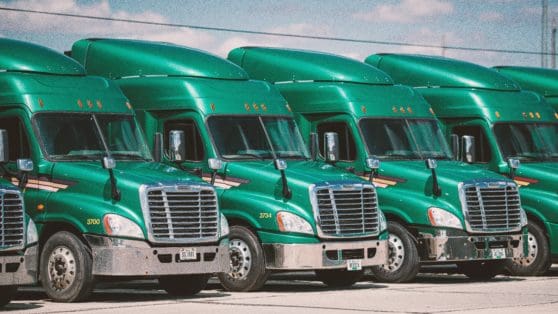With the annual accident rate for commercial fleets at approximately 20 percent, accidents are among the most costly workplace injuries for fleets. A typical workplace injury averages $35,592, while fleet accidents cost almost double. But more importantly, accidents cost lives.
While losing anyone is enough to make safety a priority, there are many reasons to build a culture of safety. In addition to protecting the bottom line, companies with strong safety cultures usually have lower employee turnover, increased engagement, and better morale. Plus, they enjoy good reputations.
Creating a driving safety culture is a team effort that requires a multi-pronged approach. Whether you have a strong safety culture in place or not, these elements will help boost your fleet’s safety culture program.
1. Set Clear Expectations
How do you create a safety culture in the workplace? It all starts with good communication. The first step is publishing a set of written policies that outline your fleet’s traffic safety expectations and procedures.
These documents should be clear, comprehensive, and enforceable. Make sure to distribute these safe driving policies on a regular basis.
Ultimately, the prominence of safety policies reflects how seriously your fleet views safety. Is it simply a box to check? Or is it an integral part of your fleet culture?
Also, you should establish a contract with all of your drivers as part of your fleet safety program for employees. By signing the contract, drivers acknowledge their awareness and understanding of your fleet’s expectations regarding vehicle maintenance, reporting violations, and safety performance.
2. Commit to Safety
While many fleets have a safety manager, employees notice whether a fleet truly places a premium on safety. Does fleet leadership attend meetings where safety is discussed? Do fleet managers encourage drivers to bring up safety issues?
When customers make demands that may impact safety, do managers ask “can we do this safely?” A culture of safety is created incrementally every day through the consistency of company messaging and the values communicated by top leadership.
3. Use Data to Align on Metrics
To create long-term behavioral changes, data measurement should be incorporated into your driver safety program. Metrics help an organization define thresholds of acceptable transgressions. They keep drivers accountable while also providing them with data to pinpoint areas that need improvement for workplace safety.
Dash cam systems that combine telematics with video are a highly effective tool for tracking and collecting fleet driving metrics. Netradyne’s dash cam solution collects a multitude of safety-related metrics, such as unsafe passing, harsh braking, speeding, and distracted driving. These metrics can be used to assess each driver’s safety habits. When safety issues are identified, they can be used as coaching opportunities.
4. Provide Driver Coaching
Even experienced drivers benefit from periodic corporate driver training. You can increase the impact of your driver safety training by regularly coaching all drivers in groups. Reserve one-on-one sessions in your fleet safety training program for drivers who drop below a predetermined safety score threshold.
To keep coaching unbiased, it’s a good idea to document your best practices and provide coaches with standardized scripts for your driver safety program for employees. Fleet safety organizations can help with this task.
Additionally, real-life dash cam video footage is an invaluable training tool. Netradyne Driveri’s DriverSTAR dash cam system records video of every road event. Discussing drivers’ firsthand experiences—and how they could’ve been handled more safely—is a highly effective coaching method for curbing dangerous behaviors and creating positive change.
5. Encourage Feedback
When building a safety culture, it’s important to reinforce safety messaging through regular safety meetings and emails about safety. Sprinkling safety messaging throughout fleet communications creates an environment where drivers feel comfortable opening up about their safety concerns. When your door is always open, you can better understand drivers’ challenges and proactively make important safety changes. Some of the best safety initiatives come from drivers themselves.
6. Share successes
Changing your safety culture requires positive reinforcement. As drivers adjust to your fleet’s safety program, it’s essential to celebrate successes. By connecting every short-term success to longer-term fleet-wide goals, every safety achievement becomes further motivation to do even better.
This doesn’t mean rewarding drivers each week or month for simply not having accidents. But it’s important to recognize drivers who achieve extraordinary safety milestones, like years without an accident. Here are a few ways to recognize exemplary safety records:
- Present the driver with a commendation from the CEO or other senior executive
- Feature the driver in an email blast or company newsletter
- Publish a news release that’s distributed to local news media
7. Offer Rewards and Incentives
Even the best fleet safety programs won’t work without driver buy-in. Remember that every accident that’s prevented represents thousands of dollars saved. A safe driving awards program enables drivers to share in some of those savings.
Whether you offer bonuses, gift cards, special privileges, or other prizes, rewards go a long way toward motivating employees to drive safer. They also improve driver retention, increase driver buy-in, and create a positive safety culture.
Final Thoughts
Leadership has a lot of power to set the tone for safety across a fleet by creating policies, communicating values, and allocating resources for safety. When a fleet builds a strong culture of safety, every driver feels responsible for their contribution to safety and will go out of their way to eliminate unsafe behaviors.
Drivers should view safety the same way they view hard work, honesty, and punctuality. By creating a safety culture, a fleet will not only save lives, it will also increase morale, improve retention, and protect the bottom line.
Learn how dash cams can support your fleet’s safety initiatives.







